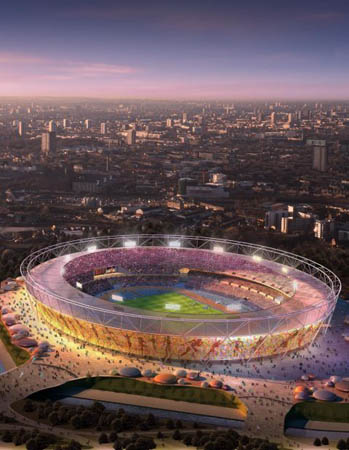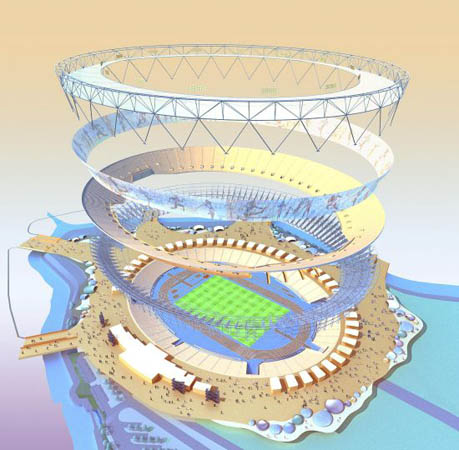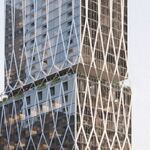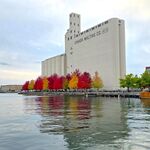wyliepoon
Senior Member
On this side of the Pond it would be called a cookie-cutter stadium.
Link to article
Long on legacy, short on wow
Jonathan Glancey
Thursday November 8, 2007
Guardian
This is a very simple building", said Rod Sheard, architect in charge of the design of the London 2012 Olympic stadium. And, I must say, it's hard to disagree. If you like your Olympic stadiums like Beijing's next year, in the guise of a giant and strangely thrilling metal bird's nest, or like Athens's in 2004, in the form of a bucking bronco engineering rollercoaster ride, then the London stadium is unlikely to be your cup of green tea, much less your shot of ouzo.
When Lord Coe unveiled the design yesterday, there was a breathless hush in the close-packed ranks of journalists assembled at the stadium site. You could have heard a hurdle drop. There was, though, no sudden burst of applause, not one "wow!"
London, it seems, is taking no chances. Although described yesterday at the official unveiling, in a cruelly wind-scythed Stratford, as "cutting edge" by the mayor of London, "a new blueprint for building Olympic stadia" by Lord Coe and "stunning" by Tessa Jowell, the Olympics minister, the £496m design looked rather tame and not a little like a conservative version of the sort of thing pop-era architects of the 60s used to dream up in swinging London but never quite got to build.
Fearful of building a Dome mark two, the Olympic committee and its designers, architects HOK Sport and engineers Buro Happold, have come up with an 80,000-seat stadium that - hey presto! - will be cut down to size, to just 25,000 seats, with precious little fuss when the Olympic Games have come and gone. So, the stadium is basically a concrete bowl - the permanent bit - with tiers of temporary seats stacked above it, with the whole caboodle wrapped in plastic sheets shot through with the kind of whizzy digital electronic technology that will allow these short-lived walls to display any images, still or moving, the Olympic committee deems fit for global public consumption in summer 2012. Given over to clever video designers and artists, this could be immense fun, and even illuminating.
Above all, though, this safe, sensible and pragmatic design has clearly been driven by the dreaded "L" word. All six speakers at the press conference used it, with Ms Jowell very probably breaking the world record with three mentions in less than 30 seconds. Not even the dashing Seb Coe could have beaten her. The word is "legacy", all the vogue in the very political circles that shaped the dread Millennium Experience a decade ago.
Sadly, no one holding an official torch for the London Olympics was willing or able to describe this "legacy". Expect, though, a huddled mass of low-cost homes, thrusting, two-fingers-up office blocks, gaudy shopping malls, a splash of artistic "water features" and a quirky new park along the banks of the river Lea in the soft shadow of a small and sensible, all-purpose post-Olympic stadium. The stadium may well go on to host a circus or two, but, matter-of-fact and just a little mousey, this will certainly be no white elephant.
· Jonathan Glancey is the Guardian's architecture critic



Link to article
Long on legacy, short on wow
Jonathan Glancey
Thursday November 8, 2007
Guardian
This is a very simple building", said Rod Sheard, architect in charge of the design of the London 2012 Olympic stadium. And, I must say, it's hard to disagree. If you like your Olympic stadiums like Beijing's next year, in the guise of a giant and strangely thrilling metal bird's nest, or like Athens's in 2004, in the form of a bucking bronco engineering rollercoaster ride, then the London stadium is unlikely to be your cup of green tea, much less your shot of ouzo.
When Lord Coe unveiled the design yesterday, there was a breathless hush in the close-packed ranks of journalists assembled at the stadium site. You could have heard a hurdle drop. There was, though, no sudden burst of applause, not one "wow!"
London, it seems, is taking no chances. Although described yesterday at the official unveiling, in a cruelly wind-scythed Stratford, as "cutting edge" by the mayor of London, "a new blueprint for building Olympic stadia" by Lord Coe and "stunning" by Tessa Jowell, the Olympics minister, the £496m design looked rather tame and not a little like a conservative version of the sort of thing pop-era architects of the 60s used to dream up in swinging London but never quite got to build.
Fearful of building a Dome mark two, the Olympic committee and its designers, architects HOK Sport and engineers Buro Happold, have come up with an 80,000-seat stadium that - hey presto! - will be cut down to size, to just 25,000 seats, with precious little fuss when the Olympic Games have come and gone. So, the stadium is basically a concrete bowl - the permanent bit - with tiers of temporary seats stacked above it, with the whole caboodle wrapped in plastic sheets shot through with the kind of whizzy digital electronic technology that will allow these short-lived walls to display any images, still or moving, the Olympic committee deems fit for global public consumption in summer 2012. Given over to clever video designers and artists, this could be immense fun, and even illuminating.
Above all, though, this safe, sensible and pragmatic design has clearly been driven by the dreaded "L" word. All six speakers at the press conference used it, with Ms Jowell very probably breaking the world record with three mentions in less than 30 seconds. Not even the dashing Seb Coe could have beaten her. The word is "legacy", all the vogue in the very political circles that shaped the dread Millennium Experience a decade ago.
Sadly, no one holding an official torch for the London Olympics was willing or able to describe this "legacy". Expect, though, a huddled mass of low-cost homes, thrusting, two-fingers-up office blocks, gaudy shopping malls, a splash of artistic "water features" and a quirky new park along the banks of the river Lea in the soft shadow of a small and sensible, all-purpose post-Olympic stadium. The stadium may well go on to host a circus or two, but, matter-of-fact and just a little mousey, this will certainly be no white elephant.
· Jonathan Glancey is the Guardian's architecture critic







